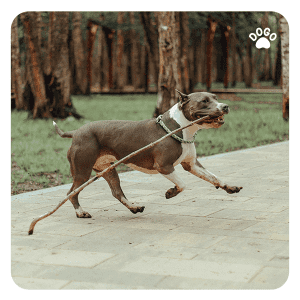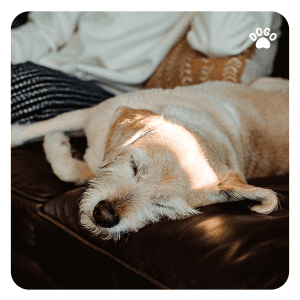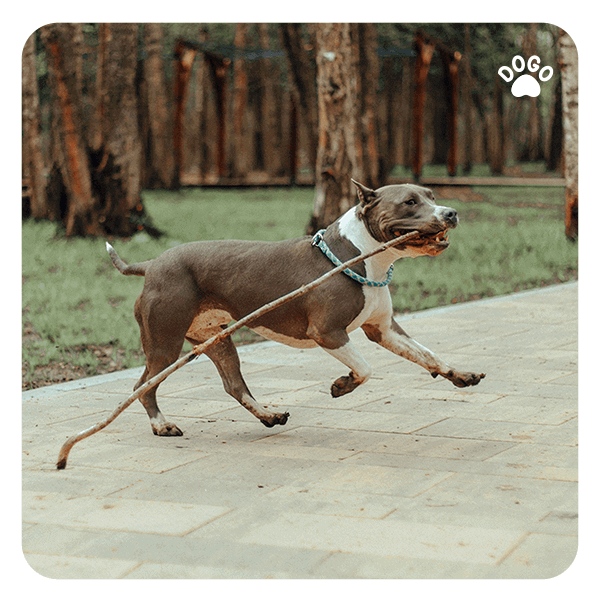Excited dogs. How can you teach them to be calm?
Tip 1 – Physical exercise
 One of the solutions most often chosen to calm active dogs is sports! We say to ourselves: “I’m going to make the dog spend all the energy so that they will be calmer afterwards.” To our surprise, the dog comes home, panting but ready to destroy chairs in the kitchen or to run after the cat! The problem is not doing sports with your dog but using physical activity as the only source of calm for our canine friends. With increasing physical exercise, your dog will build up stamina and require more activity daily. The minimum requirement for any dog is one hour of physical exercise. Just subdivide the walks or playtime into shorter sessions.
One of the solutions most often chosen to calm active dogs is sports! We say to ourselves: “I’m going to make the dog spend all the energy so that they will be calmer afterwards.” To our surprise, the dog comes home, panting but ready to destroy chairs in the kitchen or to run after the cat! The problem is not doing sports with your dog but using physical activity as the only source of calm for our canine friends. With increasing physical exercise, your dog will build up stamina and require more activity daily. The minimum requirement for any dog is one hour of physical exercise. Just subdivide the walks or playtime into shorter sessions.
Apart from physical exercise, mental exercises can also help calm your dog. For instance, you can try training your dog to learn new tricks or play interactive games such as hide and seek. These games not only help in mental stimulation but also provide a sense of accomplishment and fulfillment for your dog, which can help keep them calm. Additionally, you can also try taking your dog on different routes during walks, which can help in mental stimulation by allowing them to explore new sights and smells. Furthermore, you can also try using puzzle feeders or treat-dispensing toys, which can keep your dog engaged and mentally stimulated.
You can also read this article in Dogo App.
Tip 2 – Make sure your dog’s needs are met
The other question to ask is whether all of our dog’s needs are being met. Of course, there are basic needs like having a roof, space to move, food, and fresh water available, but dogs are unique beings who have other needs that are specific to their breed. Here are some examples:
General dog needs:
- Physical exercise/play
- Mental stimulation
- Chewing
- Socialization
- Vocalization
- Sleep
Specific needs of certain breeds:
- Digging
- Sniffing
- Herding
- Working with humans
- Chasing
These are very theoretical examples, and every dog is different, but it gives an idea! Normally, you don’t have a flock of sheep available for your sheepdog, but make sure to compensate with more chewing and mental stimulation or chasing games.
One way to ensure that your dog’s specific needs are being met is to research your dog’s breed and learn about their unique characteristics and needs. For example, some breeds require more socialization than others, while some require more mental stimulation. You can also consult with a veterinarian or a professional dog trainer to learn more about your dog’s specific needs. Another essential aspect of meeting your dog’s needs is providing a safe and comfortable environment for them. Make sure that your dog has a cozy bed to sleep on and that their living space is free from any potential hazards or dangers. Finally, spending quality time with your dog and giving them plenty of love and attention can also help keep them calm and happy.
It’s about finding what your dog likes and needs daily and making it available to them or compensating with another calming activity. Chewing is often the key to a quiet dog, as it fills the need to chew, and the action itself releases endorphins and allows the dog to relax. Make sure you have a supply of bully sticks and sturdy toys filled with food on hand. The trick with hollow stuff toys is freezing them so that they last longer. I guarantee you a calm dog after this activity!
Tip 3 – Reward calmness
 We often tend to notice the behaviors that we don’t like in our dog but fail to acknowledge the pleasant ones. Get into the habit of rewarding what you like, so your dog is more likely to repeat the behavior (positive reinforcement).
We often tend to notice the behaviors that we don’t like in our dog but fail to acknowledge the pleasant ones. Get into the habit of rewarding what you like, so your dog is more likely to repeat the behavior (positive reinforcement).
Apart from rewarding calmness, it’s also essential to avoid punishing your dog for unwanted behavior. Punishment can be counterproductive and can cause your dog to become more anxious and stressed. Instead, try to redirect your dog’s attention to something more positive when they exhibit unwanted behavior. For example, if your dog is barking excessively, you can try distracting them with a toy or treat. Additionally, it’s important to be consistent with your rewards and praise. Make sure that everyone in the household is on the same page when it comes to rewarding your dog’s positive behavior. Finally, remember to be patient and understanding with your dog. Calming a dog takes time and effort, but with the right approach, you can achieve a calm and happy companion.
Here’s a challenge for you:
1. Write down three calm behaviors that you like about your dog, for example: when your dog lies down on their bed, when the dog settles down in the living room next to you or when the cat passes by undisturbed by your dog;
2. Place small jars of treats on the shelves in different strategic places of the house;
3. Tell your family members to observe the dog during the day and give the dog a treat whenever they see the dog behaving well.
4. Every day, praise at least 5 behaviors that you like in your dog. This way, your dog will learn what makes you happy.
Tip 4 – Get to know your dog
 Every exciting or frightening event increases the level of cortisol in your dog’s blood, which is the stress hormone. This is not a bad thing, except when the stress level is constantly high, and the dog never gets a chance to calm down. If we take the example of a dog who has slept little, who played ball for 1 hour, who had a car trip and a visit to the veterinarian on the same day, there is a good chance that the dog will be in a bad mood or do bad things at the end of the day, because they reached their daily stress limit and the nervous system is overflooded! It is often an accumulation of these exciting events that can lead to bad decisions from your dog, like barking, destroying, or running into zoomies.
Every exciting or frightening event increases the level of cortisol in your dog’s blood, which is the stress hormone. This is not a bad thing, except when the stress level is constantly high, and the dog never gets a chance to calm down. If we take the example of a dog who has slept little, who played ball for 1 hour, who had a car trip and a visit to the veterinarian on the same day, there is a good chance that the dog will be in a bad mood or do bad things at the end of the day, because they reached their daily stress limit and the nervous system is overflooded! It is often an accumulation of these exciting events that can lead to bad decisions from your dog, like barking, destroying, or running into zoomies.
A good tip to help the dog deal with these energy fluctuations is to make a list with 2 columns and write it down:
• Anything that is exciting the dog (increases cortisol levels)
• Anything that calms the dog (decreases cortisol levels)
Ensure your dog does enough on the calm activity list on a single day to lower their overall cortisol levels. A good bet that “running” or “chasing the ball” will be on the exciting list if you have an energetic dog. So try to go 2 or 3 days without doing such activities and focus on the other activities: chewing, decompression walks, mental stimulation, etc. After those few days, it’s time to reintroduce exciting activities into your daily routine, but make sure a calm one follows it. For example, after playing fetch, give the dog a stuffed chew toy!
In Conclusion
There may not yet be a magic wand to calm your dog instantly. Still, several tips can be of great help: providing physical exercise, meeting your dog’s needs, rewarding calmness, and alternating between exciting and calm activities on the same day.
[/fusion_text]



